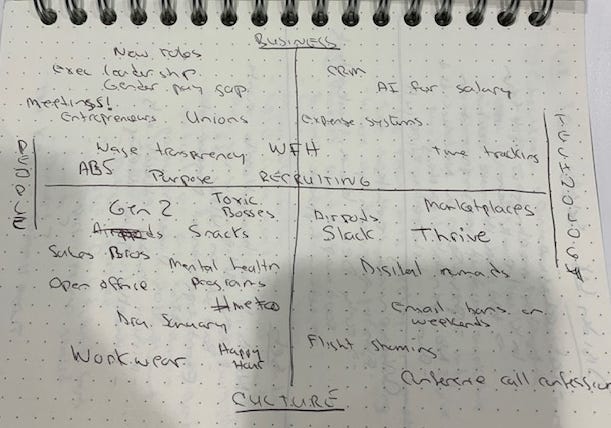The best brands are at intersections
Focus is key, but so too if finding different avenues that meet
Presenting sponsor
This week, I dug into the power of finding an intersection for media brands as well as the problem of industry experts and why an email is not really a product. Also, I’m hosting an event TRB sponsor Mediaocean is holding, The Omnichannel Imperative. It’s March 23 at 11:30amEST. Sign up.
The magic of intersections
Intersections are where two areas meet and create new dynamics. Some intersections are simple, others are very complex as all first-time visitors to Tokyo go to the Shibuya Crossing to observe the crazy scramble. This applies to the media business too. With Digiday, we focused on a simple intersection: the media and marketing industry intersecting with technology. That meant we skipped a lot of the stuff Adweek and Ad Age chewed over, like TV commercial reviews, account changes, “execs on the move” and other typical trade publication nonsense. The intersection got more complex with a new brand like Glossy, which focused on changes in the fashion and beauty industry. The dynamics changed. In those industries, tech was obviously a main driver of the change, like all industries, but there was an added layer of societal change in representation and also climate impact. What’s more, with both Digiday and Glossy, these industries had a cultural impact that made them punch above their weight.
My bet is the most interesting new focused brands that will emerge will find their own intersections. Some emerging brands nailing this:
Front Office Sports: Adam White and team are executing at a very high level in building a brand at the intersection of sports and business. Sports is not just a big business with the games, but now intersects with fashion, retail, gambling and other areas. Now, FOS is going broader with consumer-oriented newsletters. The B2B to B2C route is risky, but sports is a good area for it to work. And if being honored by this mention in TRB wasn’t enough, FOS is one of Fast Company’s most innovative companies in media.
Lean Luxe and 2PM. Both Lean Luxe and 2PM have done a great job, in different ways, of charting new aspects of a shifting retail and luxury landscape, where content and commerce intersect with culture -- and building communities.
Trapital. I only discovered Trapital a few months ago. Dan Runcie has found a great niche at the intersection of hip hop and business/tech.
Water & Music. Cherie Hu was a freelancer who decided to make her newsletter for her work into a brand. The publication sits at the corner of music and business, and has over 1,000 paying subscribers through Patreon.
We will see more brands emerge in intersections. Some areas that are ripe:
Climate tech and business. The story of rolling back the ravages of climate change is moving from one mostly at the governmental and activist level to a giant business story. There are trillions of dollars to be made in clean tech. This is one of the biggest business stories of our time.
China and anything. China will remain a bit of a mystery to many outside China. The emergence of multiple internets has shifted innovation from being a mostly Silicon Valley story to China pioneering new business models, new behaviors and super apps that fuel them. There are many opportunities for those who can have one foot in both worlds.
Blockchain and business. Forget Bitcoin for a moment. I understand the eye-rolling reflex when it comes to blockchain, but the shift to digital assets will be a giant story of our time. The wild fluctuations in the price of Bitcoin and the hype merchants and scam artists it has inevitably attracted will obscure that a bit. Reminds me of how people dismissed the internet because of the excesses of the dot-com boom. I remember being told then, after the crash, that people were too focused on the Nasdaq number and not enough on the broadband penetration number.
The future of work. The changing nature of work was not just accelerated by Covid, it was turbocharged. There are many intersections here with technology, equality, mental health and more. For fun, here’s a photo of the opportunity I sketched out pre-Covid.
Sponsor message
Join us at The Omnichannel Imperative
The biggest challenge facing advertisers is how to deliver a consistent customer experience across a bewildering array of channels and platforms. On March 23, Mediaocean is going deep into the issues in a new virtual event, The Omnichannel Imperative, that I’m hosting. Some highlights:
I will give an overview of what’s behind the push for omnichannel advertising as the media landscape fragments even further.
Forrester Research’s Joanna O’Connell will give an overview of the power of omnichannel advertising and how to overcome the challenges.
Mediaocean CEO Bill Wise will host a fireside chat with actor and Edo co-founder Edward Norton and Vista Equity Partners CEO Robert Smith.
Mediaocean will unveil its new product suite to address the needs marketers have to make omnichannel a reality.
Join us at 11:30amEST on March 23. Reserve your spot here.
The problem of “experts”
This is one of my favorite media accounts, an unvarnished take on what’s really happening in media. I think I know who they’re talking about, and I won’t pass judgement on this person’s bona fides. Reporters are always pushed to have “more voices,” in particular a third party. Reporters are busy, typically disorganized and always on deadline. That leads to the emergence of a group of go-to experts whose greatest attribute is not their expertise but their availability. To a reporter on deadline, availability is the greatest ability. Of course, these experts are marketing themselves and usually their consulting services.
When everything is productized
We live in a world where “product” is worshipped. The word is now thrown around and attached to so many things that it is in danger of joining content, mental health and toxic as words that mean so many things that they ultimately mean nothing.
My rule of thumb in media is that something hyped as a product is reliably a feature. Where this gets tricky is internally if people truly believe features, like an email newsletter, are products. If you have a single subscription to your content, that is the product. Full stop. Your various emails are features of the product; they are not themselves products. That matters because the challenge of a product is the same as that of a brand: consistency. You need to make sure your strategy is coherent and any optimization is done in service of the overall product as opposed to have a bunch of different features that don’t add up to much.
Other things to check out
I love counterfactual history. Is there a world where the ad-funded internet lives up to its billing to provide open access to a wide variety of voices while providing a sustainable business not dominated by a few tech companies? Shira Ovide ponders the possibility in the NYT’s OnTech newsletter. My argument has always been the current dysfunctional state of ad-funded digital media can be traced back to two decisions: 1. Making the click the success metric; 2. Separation the audience data from the media impression. Combined these inevitably commoditized publisher content and shifted the rewards to tech companies. Maybe, just maybe, the pivot to privacy will increase emphasis on context.
Digiday alum Kerry Flynn executed a classic check-in story to see how things are going at publications “saved” by a billionaire. Unsurprisingly it’s a very mixed bag. There is truly no panacea in media.
Digiday alums from different eras, Tanya Dua and Lara O’Reilly, combined (with Don Whately) on a deep dive that examines how Snap defied its many critics to build a thriving ad business — and a niche as inarguably the most creative of the tech platforms. Let’s remember that in 2018 Scott Galloway, who gets up to $200k a talk, said Snap and Tesla are doomed. Prophets are usually treated as lunatics because most are, in fact, lunatics.
Morning Brew founders Alex Lieberman and Austin Rief were on the How I Built This podcast to detail how their “overnight success” (for media) took six years. The truism that is the most true: It always takes twice as long as you think and is twice as hard/expensive. Good listen.






